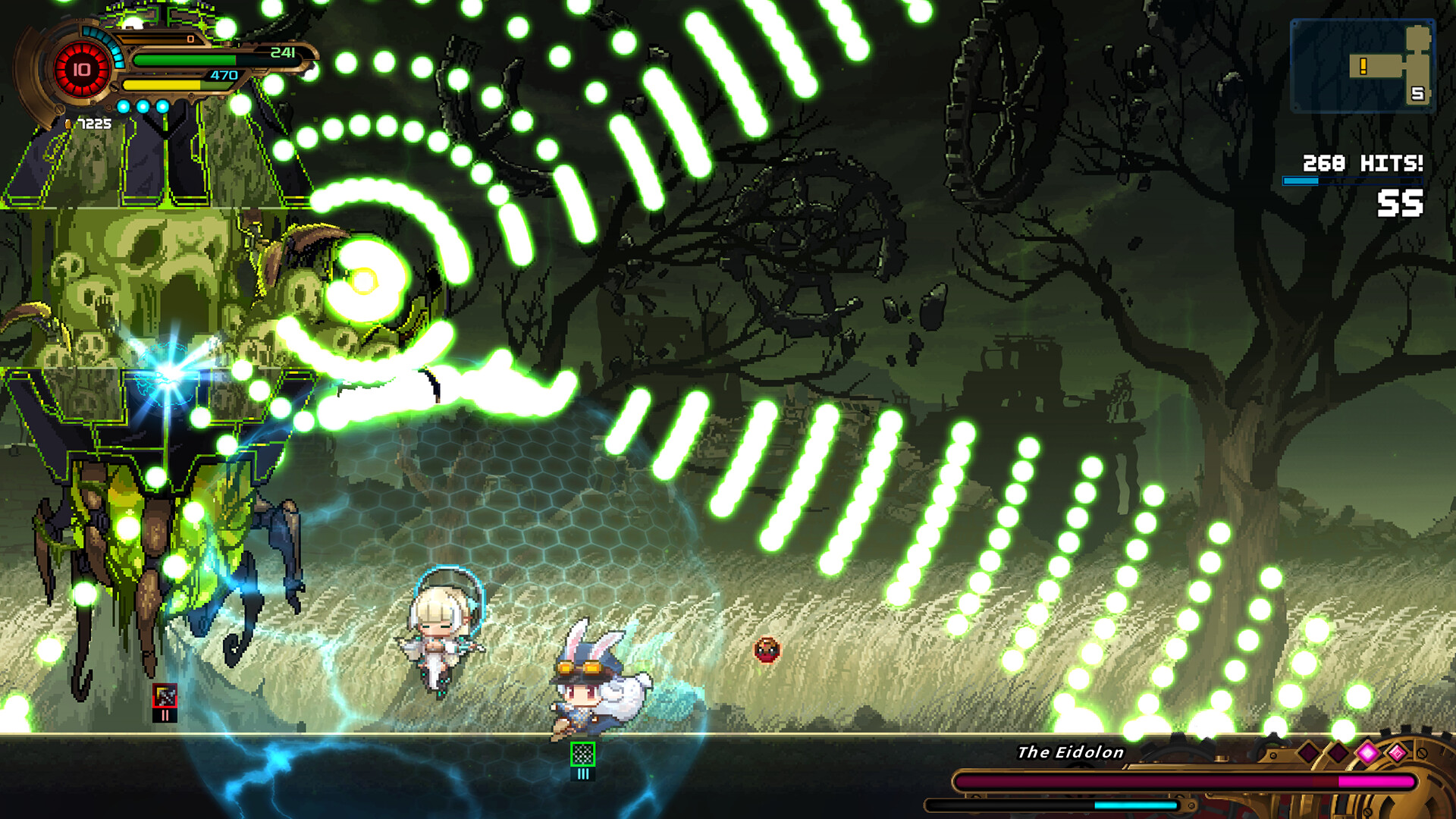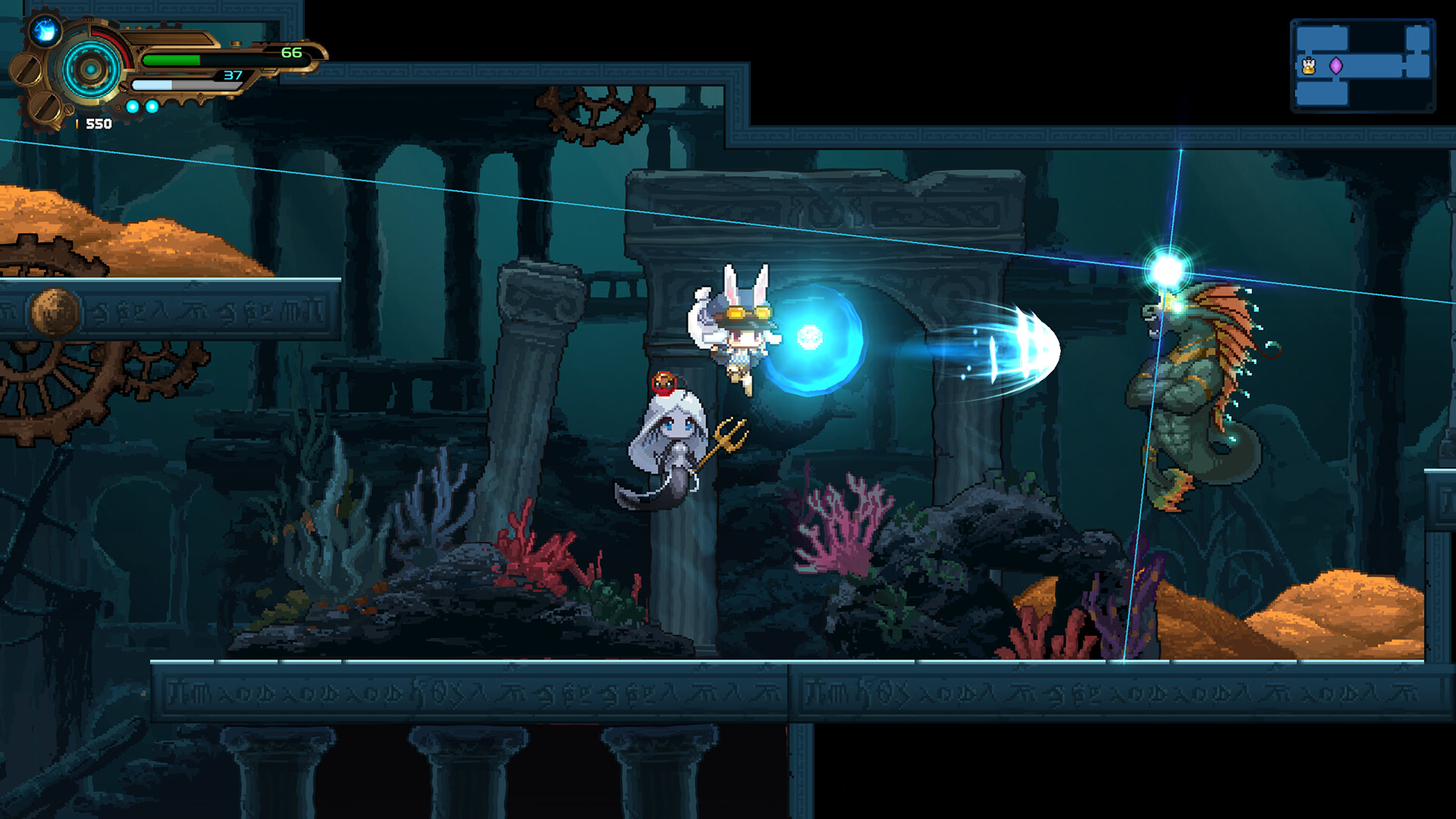It’s been almost 10 years since indie outfit CreSpirit dropped Rabi-Ribi, a nifty mashup of metroidvania and bullet hell. It didn’t make much of a splash at the time, but over time (and several console releases), the depth and creativity on display earned it cult favourite status… even if the kawaii bunny girl theme and oddball narrative remains divisive. Now, the studio is back with Tevi, an ambitious, more story-driven follow-up that pushes the foundations that Rabi-Ribi set.
In a (mostly) peaceful world that still wears the scars of a destructive war some 30 years ago, a plucky engineer turned treasure hunter—the eponymous Tevi—spends her time searching for ancient machinery and tinkering with gadgets. (When she’s not berating her dad for his weird obsession with bunny-girls, that is.) When a particularly noteworthy discovery sets Tevi on a journey across the continent, she winds up digging into a turbulent slice of history largely shrouded in mystery…
That description makes Tevi sound a lot more grim than it really is. The lighthearted tone and playful characterisation seen in Rabi-Ribi is on full display here, with an eccentric cast of lovable oddballs who somehow always land in comedic situations. The difference is an undercurrent of more serious narrative themes—the impact of war, both in the moment and in the aftermath even decades later—for the game to engage with as the writers see fit. The result? A wild adventure that’s full of laughter and over-the-top silliness, but with a bit more weight and meaning to it than you might expect.
That setup paves the way for a metroidvania (or “exploration platformer”, if you prefer) that doesn’t do too much to push the genre’s boundaries, but knows what makes these games tick and how to get the best out of them. Tevi is a nimble enough adventurer to start with, but grows much more so with a consistent stream of power-ups to aid traversal: double jumps, slides, bombs, and the like. There’s nothing here you haven’t seen before, but Tevi understands well an important metroidvania truth that too many indie efforts overlook: that an increasing degree of mobility—and the player’s growing adeptness in using those new techniques—is a much more satisfying way of progressively unlocking a world than simple keys.
Masterful level design rounds out the exploratory excellence, with a map that invites you off the beaten track, implicitly teaches you how to use your new tools, and regularly gives you chances to push your new tools to their limits. The narrative structure and upgrade progression makes Tevi a more linear game than Rabi-Ribi—a very open-ended game, seemingly designed entirely around sequence breaking—but even then, story objectives frequently branch and reconverge, allowing a decent degree of player direction. And if you want the full, no-holds-barred sequence breaking appeal of Rabi-Ribi, Tevi has a treat in store after completing its story mode…
The other side of Tevi’s coin is finely-tuned combat that blends combo-heavy melee engagements with bullet hell assaults from the many foes the game throws at you. There’s a natural ebb and flow as you weave through the mesmerising shot patterns and find openings to go on the attack, while the intricacies of a deep combo system, multi-layered enemy patterns, and Tevi’s mobility create a high skill ceiling. At the same time, careful balance and a wide array of difficulty levels keep Tevi approachable for newcomers—and, crucially, without sacrificing the core pieces of what makes the combat exciting.

The final piece of the puzzle is an impressive degree of build customisation by way of equippable sigils. There are hundreds of these to be found, offering everything from raw stat boosts, to new attacks, to tweaks in the game’s core systems. You can only equip a finite number of these at once, but the effects are so varied, and with so much potential synergy, that crafting effective builds becomes a game in itself … with the potential for some truly exquisite, borderline game-breaking results.
One of the most impressive things about Tevi is how seamlessly all these pieces fit together. Exploration, platforming, item collection, melee combat, bullet dodging, sigils, and light-touch RPG growth systems all intertwine and feed off each other. The mechanical assemblage on display here is ambitious, but it’s the finesse with which it’s executed that really shows CreSpirit’s growth: Tevi takes what Rabi-Ribi started, builds on it, and polishes the result to a sheen.
Gorgeous presentation is the finishing touch that helps bring all of the above to life. Impressive attention attention to detail in the vibrant pixel art sells the atmosphere of each location, and characters’ personalities shine through anime-style portraits and chibi sprites. The style won’t be for everyone, and a touch of Rabi-Ribi’s divisive “bunny girl” aesthetic and suggestive humour persist, but at the same time, there’s a richness and intricacy to the character designs in Tevi that its predecessor lacked.

This all amounts to an impressive result. Tevi is both a fitting follow-up to one of the most inventive indie metroidvanias of the last decade, and a game that does more than enough to leave its own mark. New ideas and thoughtful refinement of Rabi-Ribi’s foundations deliver an accomplished bullet hell platformer that’ll appeal to newcomers and vets alike.
Reviewed on Nintendo Switch with a review code provided by the publisher.
A successor of sorts to the eclectic Rabi-Ribi, Tevi delivers a more refined take on the bullet hell metroidvania, with a more ambitious story to tell—and shows how much developer CreSpirit has grown.


1 Comment
Pingback: Yeah Nah Gaming - Valentine's Day Gift Guide - Yeah Nah Gaming